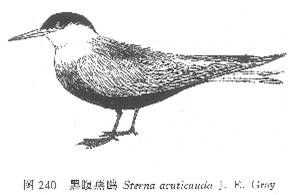| Citation |
|
Description |
Geographic Range [top]
Range Description: Sterna acuticauda is known from southern China (previously regular in Yunnan, now very rare), Pakistan (fairly common in north Sind and Punjab), India (widespread and locally fairly common, but some evidence for localised declines), Nepal (once locally fairly common, declining since the early 1990s at least, and judged to be a rare and very local visitor in the lowlands, with a maximum population of 20 estimated in 2011 [C. Inskipp and H. S. Baral in litt. 2011]), Bangladesh (previously common, now a local breeder; the provenance of some recent records has been questioned [P. Thompson in litt. 2011]), Myanmar (previously abundant, now declining rapidly and a scarce to uncommon resident, with some surveys since 2002 failing to record the species at all [J. C. Eames in litt. 2012]), Thailand (formerly resident in the north-west, now very rare and probably extinct as breeding species), Laos (previously bred in large numbers along the Mekong channel, now very rarely recorded), Cambodia (in early 1960s the species was apparently fairly common along the Mekong; the last breeding record was of just two pairs in 2003 [C. Poole in litt. 2003], and it is now considered probably extinct there [Goes et al. 2010]) and Vietnam (formerly occurred regularly in Cochinchina, and occasionally in Annam, but now probably extinct). There has been a precipitous decline in South-East Asia and it is now almost extinct in the region. Despite its large range, the species may now number fewer, perhaps significantly fewer, than 10,000 mature individuals (Perennou et al. 1994, S. Mahood in litt. 2012).
Countries occurrence:
Native:
Bangladesh; Cambodia; India; Lao Peoples Democratic Republic; Myanmar; Nepal; Pakistan; Thailand; Viet Nam
Vagrant:
China
Additional data:
? Continuing decline in area of occupancy (AOO): Yes
? Extreme fluctuations in area of occupancy (AOO): No ? Estimated extent of occurrence (EOO) - km2: 4490000
? Continuing decline in extent of occurrence (EOO): Yes ? Extreme fluctuations in extent of occurrence (EOO): No
? Continuing decline in number of locations: Yes
? Extreme fluctuations in the number of locations: No
? Upper elevation limit (metres): 700
Range Map: Click here to open the map viewer and explore range.
Population [top]
Population: Despite its large range, the species could now number fewer, perhaps significantly fewer, than 10,000 mature individuals (Perennou et al. 1994, S. Mahood in litt. 2012), although this may be over-cautious (BirdLife International 2001). The population estimate is currently placed at 10,000-25,000 individuals, roughly equating to 6,700-17,000 mature individuals, until more data are available.
Trend Justification: A very rapid and on-going decline is suspected based on the comparison of its current rarity and former abundance in many parts of its range, as well as the prevalence of a multitude of threats.
Current Population Trend: Decreasing
Additional data:
? Number of mature individuals: 6700-17000 ? Continuing decline of mature individuals: Yes
? Extreme fluctuations: No ? Population severely fragmented: No
? Continuing decline in subpopulations: Unknown
? Extreme fluctuations in subpopulations: No ? All individuals in one subpopulation: No
Habitat and Ecology [top]
Habitat and Ecology: It is found on large rivers (usually breeding on sandspits and islands) and marshes, occasionally on smaller pools and ditches, in lowlands (but not on the coast), up to 730 m.
Systems: Terrestrial; Freshwater
Continuing decline in area, extent and/or quality of habitat: Yes
Generation Length (years): 11
Movement patterns: Not a Migrant
Congregatory: Congregatory (and dispersive)
Threats [top]
Major Threat(s): Threats include the destruction of breeding habitat (islands and sandspits in larger rivers are increasingly cultivated), the collection of eggs for food, overfishing and the flooding of nests, often caused by dams. Increased disturbance and over-harvesting of wetland products are blamed for the recent complete disappearance of the breeding population within Chitwan National Park (Nepal) (F. Cuthbert in litt. 2002). River damming, disturbance, predation by dogs and egg collecting are highlighted as causes of the species’s disappearance from Cambodia (Goes et al. 2010). In India, the species faces many threats, which include, in addition to those already listed, water extraction, sand and gravel extraction for development, disturbance and predation by cats, dogs and corvids, such as House Crows Corvus splendens, which are attracted to human settlements, pollution from industry and agriculture, and mortality through fisheries bycatch (A. Rahmani in litt. 2010, S. Mahood in litt. 2012).
Conservation Actions [top]
Conservation Actions: Conservation Actions Underway
It is known from a number of protected areas throughout its range, including Harike Wildlife Sanctuary, Keoladeo National Park, Rajiv Gandhi National Park, Dibru-Saikhowa National Park and Kaziranga National Park.
Conservation Actions Proposed
Organise a population census in Pakistan, India, Bangladesh and Nepal during the breeding season, and conduct further surveys in Myanmar to clarify its current distribution and status. Monitor population trends through regular surveys across its range. Carry out awareness-raising activities to alleviate human pressures on riverine ecosystems. Campaign for increased representation of large waterways in protected-area systems.
Citation: BirdLife International. 2016. Sterna acuticauda. The IUCN Red List of Threatened Species 2016: e.T22694711A93464699. http://dx.doi.org/10.2305/IUCN.UK.2016-3.RLTS.T22694711A93464699.en. Downloaded on 20 January 2017.
Disclaimer: To make use of this information, please check the .
Feedback: If you see any errors or have any questions or suggestions on what is shown on this page, please provide us with feedback so that we can correct or extend the information provided
|


